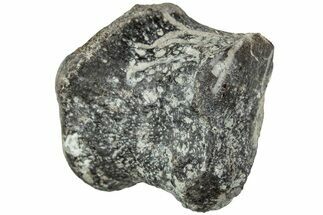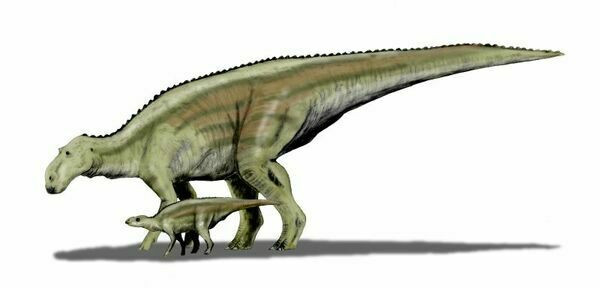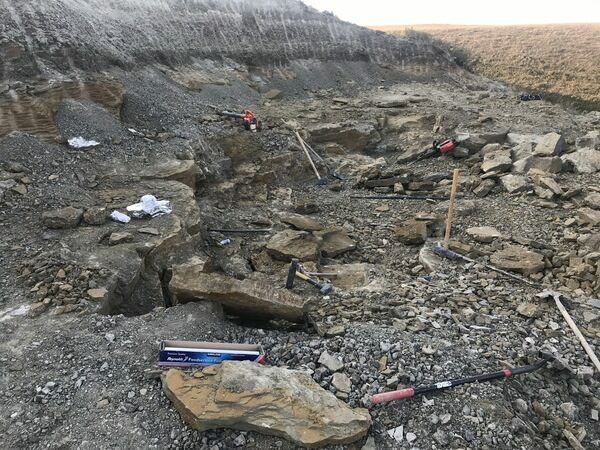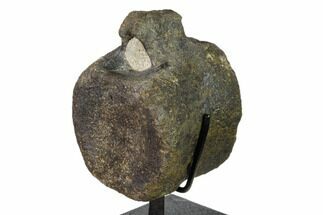This Specimen has been sold.
13.3" Articulated Hadrosaur (Maiasaura) Caudal Vertebrae - Montana
This is a very interesting specimen that was recently collected from the Late Cretaceous-aged Two Medicine Formation in Montana. What we have here are six naturally associated caudal vertebrae of the Hadrosaur Maiasaura peeblesorum. Each vertebra has portions of its spinous process still present. The entire string of vertebrae measures 13.3" long and is accompanied by a display stand.
There is restoration in spots where the bone had crumbled away within the rock. Most of the restoration can be found through the pedicle region of each vertebra where the process had to be repaired or reattached. Gap fill restoration was required between some of the vertebrae where rock was removed and they became disarticulated.
There is restoration in spots where the bone had crumbled away within the rock. Most of the restoration can be found through the pedicle region of each vertebra where the process had to be repaired or reattached. Gap fill restoration was required between some of the vertebrae where rock was removed and they became disarticulated.
Maiasaura, meaning "good mother reptile" or "good mother lizard", is a large herbivorous hadrosaur ("duck-billed") dinosaur that lived in what is now Montana in the Upper Cretaceous Period, about 76 million years ago. The first Maiasaura fossils were discovered in 1978. The name refers to the find of nests with eggs, embryos, and young animals in a nesting colony. This find revealed that Maiasaura fed its young while they were in the nest, the first time such evidence was obtained for a dinosaur. Maiasaura reached lengths of around 30 feet long, making it a fairly large Hadrosaur. Young animals walked on their hind legs, while adults walked on all fours.
About The Two Medicine Formation
The Two Medicine Formation is a geographical formation in Central Montana and Southern Alberta, Canada. The formation is predominantly sandstone laid down by rivers and deltas during the Campanian Age of the Cretaceous, about 80-75 million years ago. Approximately two thousand feet thick on the western edge, it lies on top of the Virgelle Sandstone formation and under the Bearpaw Shale. It is located between the Front Range of the Rocky Mountains and the Sweetgrass Arch, a tectonic fold feature 40-90 miles east of the Front Range.
The Two Medicine is the same age as the Judith River Formation found further east. It was laid down further inland from the Western Interior Seaway, while the Judith River Formation was deposited along the coast. The Two Medicine contains much of the same dinosaur fauna, but fewer reptiles, amphibians, and aquatic fossils.
The Two Medicine Formation is a geographical formation in Central Montana and Southern Alberta, Canada. The formation is predominantly sandstone laid down by rivers and deltas during the Campanian Age of the Cretaceous, about 80-75 million years ago. Approximately two thousand feet thick on the western edge, it lies on top of the Virgelle Sandstone formation and under the Bearpaw Shale. It is located between the Front Range of the Rocky Mountains and the Sweetgrass Arch, a tectonic fold feature 40-90 miles east of the Front Range.
The Two Medicine is the same age as the Judith River Formation found further east. It was laid down further inland from the Western Interior Seaway, while the Judith River Formation was deposited along the coast. The Two Medicine contains much of the same dinosaur fauna, but fewer reptiles, amphibians, and aquatic fossils.
SPECIES
Maiasaura peeblesorum
LOCATION
Montana
FORMATION
Two Medicine Formation
SIZE
13.3 x 7.9 x 2.7"
CATEGORY
SUB CATEGORY
ITEM
#227424
We guarantee the authenticity of all of our specimens.
 Reviews
Reviews




















